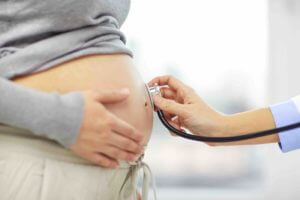Vena cava compression syndrome or vena cava syndrome is a complication that can occur during pregnancy. Due to high pressure on the inferior vena cava, blood circulation is interrupted and this can result in an undersupply of the child.
Many pregnant women also fear the increased risk of thrombosis. We explain the dangers, how you can recognize the signs of thrombosis and how you can minimize these risks.
Table of contents
Vena Cava – What Is It?
You have two large vena cava:
- Superior vena cava = upper/anterior vena cava.
- Inferior vena cava = inferior/posterior vena cava.
With a diameter of about 2 cm, they are the largest veins in your body and transport venous (oxygen-poor) blood back to the heart.
Depending on heart action, breathing, body position, and other factors, the cross-section of the vena cavae and the volume of fluid varies.
Central venous pressure (CVP) is approximately 0-15 mmHg (millimeters of mercury). Pressure variations in CVD are due to the action of the heart and are referred to as venous pulse.
Superior Vena Cava And Inferior Vena Cava
The superior vena cava is the superior vena cava, which has no venous valves. It runs in the chest cavity and opens directly into the right atrium of your heart.
Its function is to transport venous blood from the upper extremities and from the head and neck to the heart.
The inferior vena cava is located in the thoracic and abdominal cavities. It transports venous blood from the lower part of the body (abdominal, pelvic, and leg regions) to the heart.
In the region of the eighth thoracic vertebra, this vena cava pierces the diaphragm and runs in the thoracic cavity to the right pleural cavity of the heart.
Vena Cava Syndrome: Causes And Symptoms
Your unborn child is growing and thriving, getting bigger, and your abdominal girth continues to increase. As your belly grows, the supine position is uncomfortable for many women and you automatically turn onto your side.
Why is this? The great inferior vena cava runs behind the uterus and carries venous blood to the heart. As pregnancy progresses, the risk of compression syndrome increases significantly.
When you lie on your back, the weight of the baby puts a lot of pressure on the vena cava. This results in less venous blood flowing to the heart and congestion in the lower body.
This interruption can cause circulatory problems after some time. Fortunately, the typical symptoms of vena cava syndrome can be easily identified:
- Blood pressure drops suddenly.
- Dizziness.
- Nausea.
- Paleness.
- Cold feeling in the neck.
- Sweating (cold sweat).
- Shortness of breath.
- Palpitations.
- Fainting (rare).
Relief Of The Vena Cava
As the baby’s weight increases, pressure on the inferior vena cava increases in the third trimester. From about the 28th to 30th week of gestation, the risk of the vena cava being squeezed during prolonged lying on the back increases.
If you notice the signs described above, you should react immediately. If you sit up in an upright position, this will relieve the pressure on the vena cava.
In some cases, it is sufficient to simply turn to the left side. In this way, the uterus shifts, and the vena cava, which runs slightly on the right side, is immediately relieved.
If there is no improvement after sitting up or repositioning, a cardiovascular shock may occur in the further course.
In this case, the emergency physician must be called immediately so that the pregnant woman’s circulation can be stabilized in the hospital.
In addition, the unborn child is examined and the fetal heartbeat is checked by cardiotocography (CTG).
If the blood supply has been cut off for too long, a cesarean section may be necessary to be on the safe side.
Vena Cava Syndrome: Danger For The Unborn Child?
Your child is connected to you via the umbilical cord and is supplied with oxygen via the placenta. If vena cava syndrome occurs, this affects both mother and child.
The sudden drop in blood pressure can lead to circulatory problems in the placenta. As a result, the baby’s heartbeat slows down and there may be a long-term undersupply.
In this case, a cesarean section is almost inevitable. In most cases, the symptoms can be quickly remedied, so only in extremely exceptional cases is there a danger to the life of mother and child.
Prevention Is Better Than Aftercare
The risk of vena cava syndrome can be significantly minimized if you avoid the supine position. In the last trimester, it is recommended that you do not lie flat on your back for long periods of time. This way you can also avoid back pain during pregnancy.
Most pregnant women intuitively lie on their left side and thus automatically relieve the lower vena cava. If you support the baby’s belly with a small pillow or breastfeeding pillow, the side position becomes much more comfortable.
Thrombosis – Signs, Causes And Symptoms
In thrombosis, a blood clot forms and can cause different symptoms. In principle, thrombosis can occur in any blood vessel, but in most cases, it is thrombosis of the veins.
More than 90 percent occur in the leg and pelvic area.
Pregnant women are at ten times the risk of developing thrombosis.
This complication occurs comparatively frequently and, in the worst case, can lead to an acute circulatory disorder of the lungs pulmonary embolism.
Since blood flows more slowly in the legs, thrombosis in the leg veins is a comparatively common complication. Inflammation of the veins (phlebitis) is considered a precursor of thrombosis.
Signs are:
- Feeling of heaviness in the legs.
- Swelling of the legs.
- Protrusion of veins (warning veins).
- Pulling in the calves.
- Feeling of warmth in the skin.
- Redness.
- Feeling of tension.
Among physicians, phlebitis is considered an alarm signal for thrombosis.
These signs are usually minimized in a lying position. Symptoms of thrombosis, such as a calf that is sensitive to pressure, painful swelling of the leg, or a blue-violet discoloration are serious indications of thrombosis in the leg.
In these cases, you should consult a doctor immediately.
However, it is relatively common that there are no visible signs of thrombosis. In most cases, thrombosis forms in the deeper leg and pelvic veins, which is why it is also called deep vein thrombosis.
Thrombophlebitis, deep vein thrombosis Other Forms Of Thrombosis
In thrombophlebitis, the veins immediately below the surface of the skin are affected. This is a typical complication of varicose veins and classically shows the following signs of thrombosis:
- Pain.
- Swelling.
- Overheating.
- Redness.
Deep Vein Thrombosis Of The Leg And Pelvis
In most cases, the blood clot thrombus develops in the veins of the calf muscles.
Smaller clots enlarge rapidly and can lead to vascular occlusion. If the thrombosis reaches the deep popliteal vein and then travels on to the deep femoral vein, deep vein thrombosis of the leg occurs.
Typical signs of thrombosis include swelling, pressure-like pain, and bluish discoloration.
If thrombosis of the inferior vena cava occurs, inpatient treatment in a hospital is almost unavoidable.
The classic symptoms of thrombosis, in this case, are marked swellings in both legs.
As a pregnant woman, you are at increased risk of thrombosis. The development of thrombosis is favored by various factors, especially lack of exercise is an important aspect.
Due to the increased blood clotting, the increased risk continues for more than 12 weeks after birth. The clotting system only gradually returns to normal, so it is worth keeping a sensitive eye out for possible signs of thrombosis even after delivery.













1 thought on “Vena Cava Syndrome: What Are The Risks For Mother And Child?”